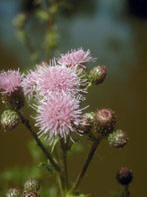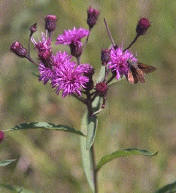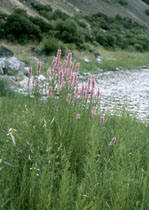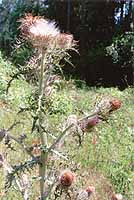Wildflower Meadows:
An Alternative to Lawns
Mary Ann Ryan
Adams County Master Gardener
 It’s time to consider an alternative to lawn. Why? Due to the continual suburban development, more of our native vegetation and
wildlife habitat is being lost. By replacing some of your lawn areas with native vegetation, you can provide food and cover for a variety of wildlife. This will provide much-needed habitat to our declining native meadows.
It’s time to consider an alternative to lawn. Why? Due to the continual suburban development, more of our native vegetation and
wildlife habitat is being lost. By replacing some of your lawn areas with native vegetation, you can provide food and cover for a variety of wildlife. This will provide much-needed habitat to our declining native meadows.
What, where and when should you plant your wildlife meadow? The best time is in the fall or early spring. The best location for a meadow is in the full sun. Most of the meadow mixes have perennial seeds and annual seeds that prefer lots of sun.
Be sure to remove all weeds and grasses before planting anything. Remove existing lawn with a sod cutter, a shovel, an herbicide, or by covering it with black plastic. Keep in mind if you are using plastic to kill grasses and weeds, it will take up
to 3 months for the plants to die. Whatever your tool, be sure to be rid of all grasses and weeds. The meadow plants will be most successful with a smooth, weed-free soil.
The easiest and least expensive way to achieve a meadow is to start with seeds. You can use a broadcast spreader to evenly disperse the seeds across the weed-free soil. Lightly rake the seed so you have some soil cover. You could use a light layer of
mulch to help keep the soil moist. Just as if you were starting a lawn, you will need to water during the fist six weeks.
If you have a large area that you wish to turn into meadow, you could simply stop mowing and let nature takes its course. Many wildflowers will naturally begin to take over your designated meadow all on their own. The disadvantage to this is that you
have little control over which species will live in your meadow. To manage the plants that you may not want in your meadow, you can pull out the unwanted species and remove the seed heads before the seeds disperse. With patience and good management, you will have a meadow
for all to envy!
Keep in mind that as your new meadow develops and gets established, weeds will invade. The first year of a newly planted meadow will require more frequent mowing. The first mowing should be before the weeds reach a height of 8 inches. Cut to about 4
inches. This will help to control the weed seed heads from developing and then dispersing. At the end of the growing season, allow the plants to reach a height of 6 to 8 inches to allow for over wintering protection for the new plants.
Once your meadow is established, yearly mowing will be needed. Often it is done in the fall to "tidy up" after the plants have gone to seed. Mowing can also be done in the spring, depending on your preference.
Before developing a meadow, check your local ordinances. Some communities may have a weed ordinance, which could lead to controversy over natural landscaping. You can apply for a variance. Start with a smaller planting and then expand, making people
aware and appreciative of what you are doing for the environment and wildlife.

Canada thistle
Cirsium arvense |

Ironweed
Vernonia noveboracensi |

Purple Loosestrife
Lythrum salicaria |

Bull Thistle
Cirsium vulgare |
When selecting a meadow or wildflower mix, be sure to read what plant species are in the mix. Often times you will receive an annual mix, which will give you great color the first year, but will need to be replanted every year. Try to locate a mix that has mostly perennial seeds. Although perennial grasses and flowers take a longer period of time to get established, often times 2 to 3 years, your meadow will reward you in the long run.
Some plants you want to avoid in any mix: Bull thistle, Canada thistle, Crown vetch Dame’s rocket, Nodding thistle, and Purple loosestrife. In Pennsylvania, planting any of the thistles is not permitted. Some plants that you would want to include in
your meadow are: Black-eyed Susan, liatris, butterfly weed, evening primrose, milkweed, helenium, goldenrod, coneflower, asters, ironweed, obedient plant, and hardy geranium.
Consider starting a meadow. Even if you begin with a small area, you will find enjoyment and satisfaction in knowing how much you, in your own little way, are making a difference for our wildlife and environment.
Read other articles on ecological gardening & native plants
Read other articles on lawn care & weed control
Read other spring related gardening articles